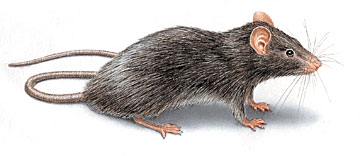It likely originated in the indian subcontinent but is now found worldwide.
Roof rat biology.
The roof rats become sexually mature in just a couple months.
Roof rats may be identified by the following physical features.
Roof rats can fit through holes as small as one half inch in diameter.
Roof rats can be black or brown.
Roof rats have evolved to prefer to eat wheat corn seeds vegetables and fruit.
The roof rat has a pointed nuzzle and ears that are long enough to be pulled over its eyes.
The two most common rats in the pacific northwest are the roof rat and the norway rat.
How did i get roof rats.
Rat behavior and biology anne s rat page welcome to my website about rats.
Roof rats habits and biology.
Their undersides are often white gray or black.
It is sometimes kept as a pet.
The norway rat is the more common of the two rodent species.
The black rat also known as ship rat roof rat or house rat is a common long tailed rodent of the stereotypical rat genus rattus in the subfamily murinae.
Because the roof rats climb well common nesting sites are above the ground.
The roof rat appears sleek and graceful.
The roof rat s adult head and body length is about 13 to 18 inches long including its tail.
They have 4 6 litters per year.
They will nest in trees attics voids along the roof line and in ceilings.
Roof rats are more aerial than norway rats in their habitat selection and often will live in trees or on vine covered fences.
Females become sexually mature in 68 90 days with 5 8 pups per litter.
I have written a number of articles about rat behavior and biology.
The norway rat is larger and more robust.
It is a generalist omnivore and a serious pest to farmers because it feeds on a wide range of agricultural crops.
These articles are based on my study of the scientific literature available on rats and on my own observations of rat behavior.
The black rat is black to light brown in colour with a lighter underside.
They ll sometimes occasionally nest on the ground under piles of debris in stacks of firewood in abandoned vehicles and in other protected places.
Roof rats are sometimes found living in or around.
But they feel more comfortable in higher places.
They have smooth fur with hairless scaly tails that are longer than their heads and bodies.
Landscaped residential or industrial areas provide good habitat as does vegetation of riverbanks and streams.
The roof rat is typically all one uniform color ranging from white buff or gray with pointed muzzles long ears and long scaly tails.
The norway rat is typically white with gray underfur blunted muzzles short ears and shorter tails.
Roof rats have soft and smooth fur that is typically brown with intermixed spots of black.
Adult roof rats measure 6 8 16 20 cm when combining their head and body length.
They will often move into sugarcane and citrus groves.
These rodents have long tails large ears and eyes and pointed noses.
Because they prefer to be high in the air these rodents may climb on power lines or tree branches to get on the roof.

